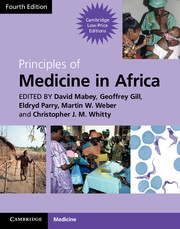Book contents
- Frontmatter
- Contents
- Contributors
- Foreword
- Section 1 Health and disease
- Section 2 Mother and child health
- Section 3 Infection: general principles
- Section 4 Major common infections
- Section 5 Bacterial infections
- 22 Typhoid, paratyphoid and non-typhoid Salmonella infections
- 23 Streptococcus pyogenes and Staphylococcus aureus
- 24 Rickettsial infections
- 25 Brucellosis
- 26 Leptospirosis
- 27 Relapsing fever
- 28 Plague
- 29 Anthrax
- 30 Tetanus
- 31 Diphtheria
- 32 Leprosy
- 33 Cholera
- Section 6 Viral Infections
- Section 7 Protozoal infections
- Section 8 Helminth infections
- Section 9 Fungal infections
- Section 10 Non-communicable diseases
- Section 11 Diseases of body systems
- Section 12 Cancer and Palliative Care
- Section 13 Venoms and Poisons
- Index
- References
33 - Cholera
from Section 5 - Bacterial infections
Published online by Cambridge University Press: 05 March 2013
- Frontmatter
- Contents
- Contributors
- Foreword
- Section 1 Health and disease
- Section 2 Mother and child health
- Section 3 Infection: general principles
- Section 4 Major common infections
- Section 5 Bacterial infections
- 22 Typhoid, paratyphoid and non-typhoid Salmonella infections
- 23 Streptococcus pyogenes and Staphylococcus aureus
- 24 Rickettsial infections
- 25 Brucellosis
- 26 Leptospirosis
- 27 Relapsing fever
- 28 Plague
- 29 Anthrax
- 30 Tetanus
- 31 Diphtheria
- 32 Leprosy
- 33 Cholera
- Section 6 Viral Infections
- Section 7 Protozoal infections
- Section 8 Helminth infections
- Section 9 Fungal infections
- Section 10 Non-communicable diseases
- Section 11 Diseases of body systems
- Section 12 Cancer and Palliative Care
- Section 13 Venoms and Poisons
- Index
- References
Summary
The problem in Africa
Cholera, caused by Vibrio cholerae, is an ancient, devastating diarrhoeal disease with its traditional ‘heartland’ in the Ganges delta on the Indian subcontinent, where it was described as early as the fifteenth century. There are reports of a cholera-like illness in Africa in the seventeenth century.
Six pandemics of classical cholera occurred from 1817 until 1960. The emergence of the new ‘El Tor’ biotype in 1961 led to the present seventh pandemic of cholera, which spread world-wide and arrived in Africa in 1970. Cholera has since been epidemic throughout Africa and endemic in some areas. Larger outbreaks throughout history have often been related to war and the consequent displacement of peoples, refugee camps, famine and flooding. There have been recent prolonged outbreaks in Angola, Ethiopia, Somalia and Sudan. Most notably, Zimbabwe has recently experienced the largest and most extensive epidemic of cholera yet recorded in Africa. The outbreak started on the outskirts of Harare and spread through urban areas to rural Zimbabwe and bordering nations and this epidemic highlights the risk posed by cholera following a combination of breakdown in clean water supply and sewage disposal coinciding with the collapse of public health services (Mason, 2009).
- Type
- Chapter
- Information
- Principles of Medicine in Africa , pp. 363 - 367Publisher: Cambridge University PressPrint publication year: 2013



